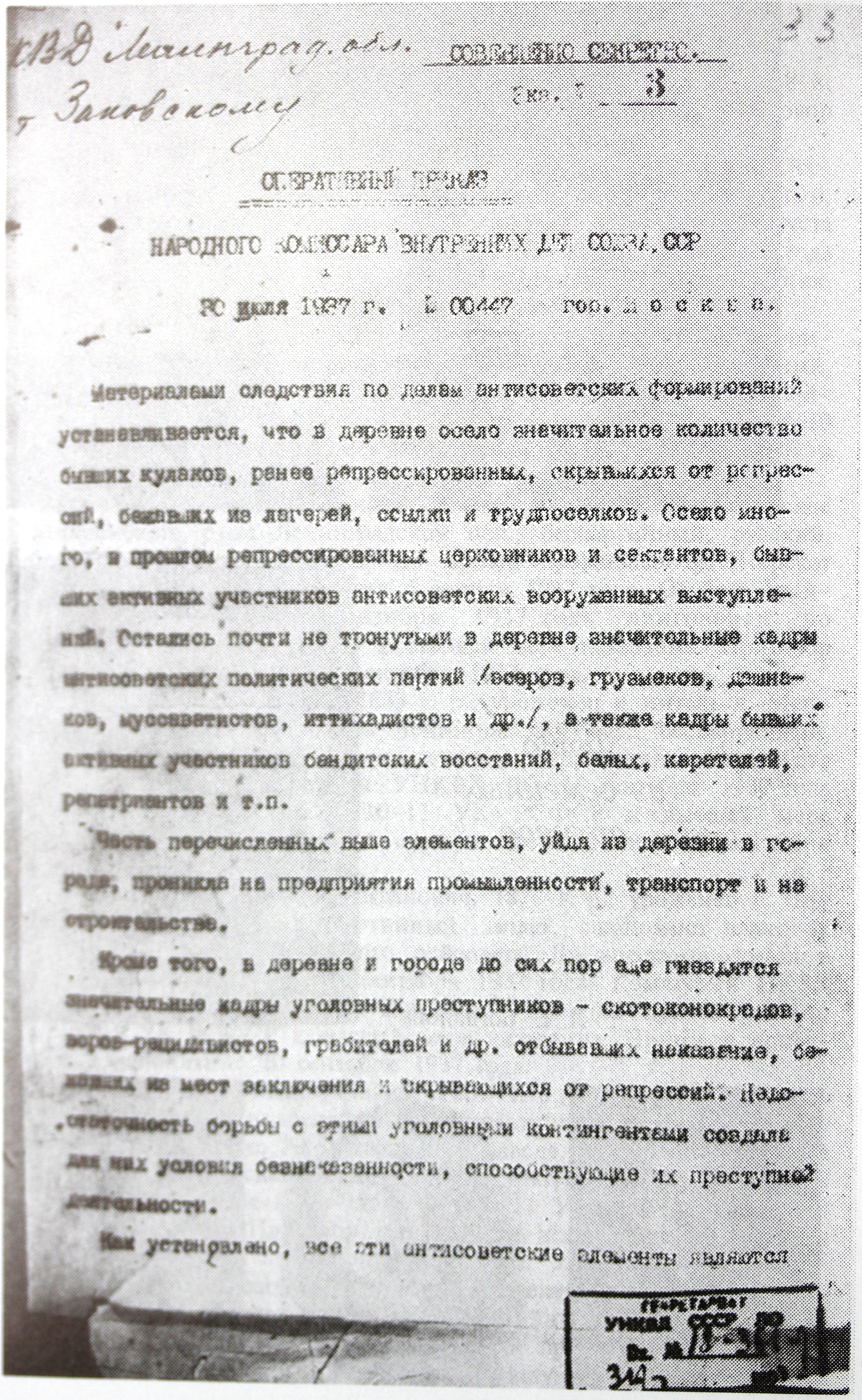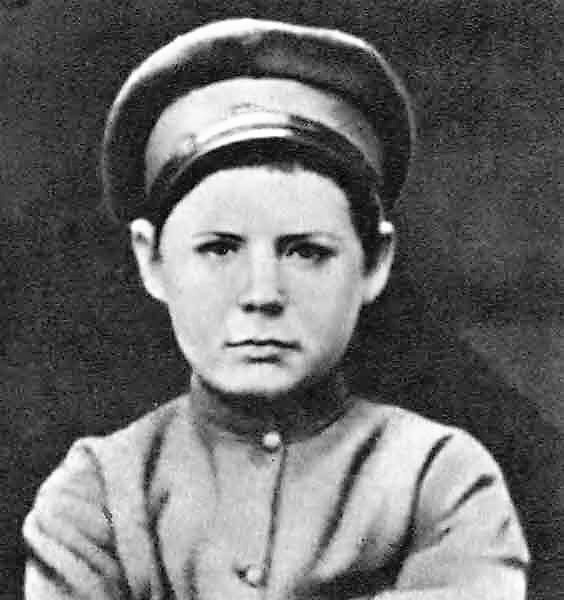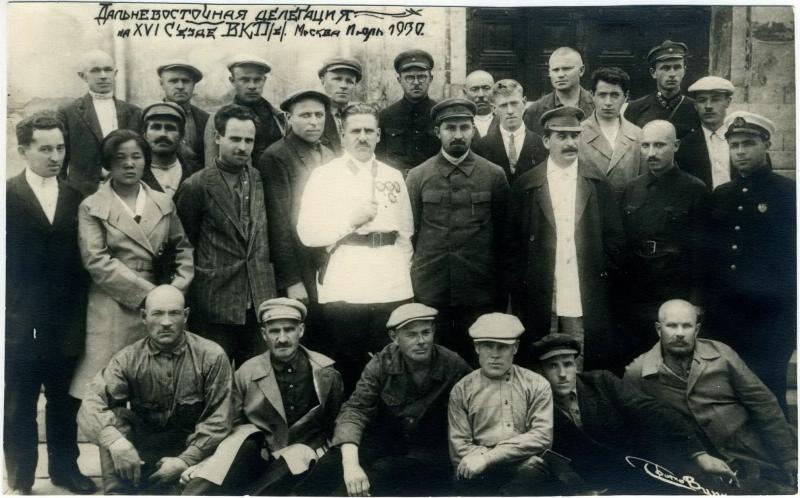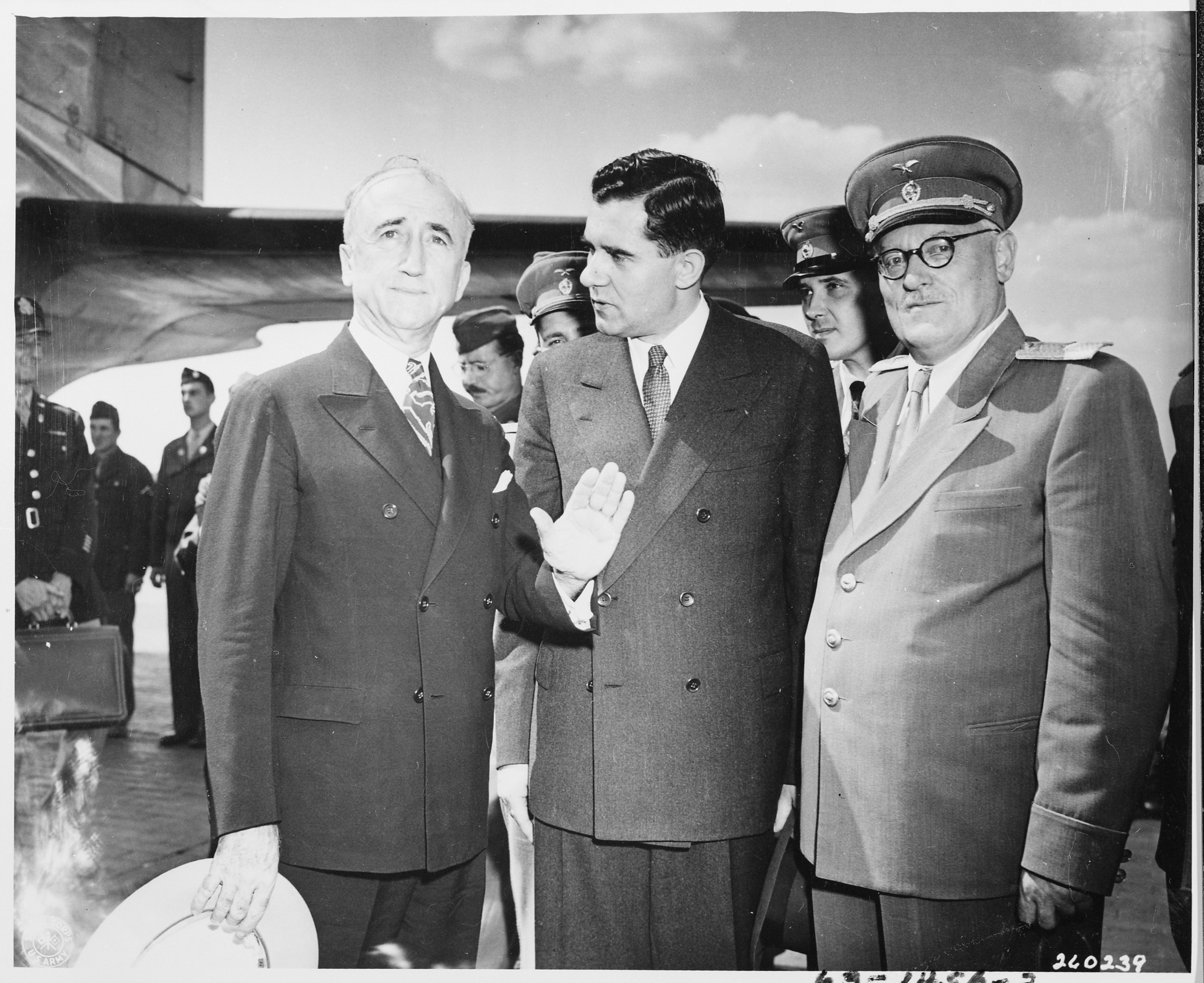|
Stalinist Purges
The Great Purge, or the Great Terror (), also known as the Year of '37 () and the Yezhovshchina ( , ), was a political purge in the Soviet Union that took place from 1936 to 1938. After the assassination of Sergei Kirov by Leonid Nikolaev in 1934, Joseph Stalin launched a series of show trials known as the Moscow trials to remove suspected party dissenters from the Communist Party of the Soviet Union, especially those aligned with the Bolshevik party. The term "great purge" was popularized by the historian Robert Conquest in his 1968 book '' The Great Terror'', whose title was an allusion to the French Revolution's Reign of Terror. The purges were largely conducted by the NKVD (People's Commissariat for Internal Affairs), which functioned as the interior ministry and secret police of the USSR. Starting in 1936, the NKVD under chief Genrikh Yagoda began the removal of the central party leadership, Old Bolsheviks, government officials, and regional party bosses. Sovi ... [...More Info...] [...Related Items...] OR: [Wikipedia] [Google] [Baidu] |
Purges Of The Communist Party Of The Soviet Union
Purges of the Communist Party in the Soviet Union (, ', "cleansing of the party ranks") were Soviet political events, especially during the 1920s, in which periodic reviews of members of the Communist Party of the Soviet Union, Communist Party were conducted by other members and the security organs to get rid of "undesirables". Such reviews would start with a short autobiography from the reviewed person and then an interrogation of him or her by the purge commission, as well as by the attending audience. Although many people were victims of the purge throughout this decade, the general Soviet public was not aware of the purge until 1937. Although the term "purge" is largely associated with Stalinism because the greatest of the purges happened during Stalin's USSR, Stalin's rule, the Bolsheviks carried out their first major purge of the party ranks as early as 1921. Approximately 220,000 members were purged or left the party. The Bolsheviks stated as justification the need to get ... [...More Info...] [...Related Items...] OR: [Wikipedia] [Google] [Baidu] |
Genrikh Yagoda
Genrikh Grigoryevich Yagoda (, born Yenokh Gershevich Iyeguda; 7 November 1891 – 15 March 1938) was a Soviet secret police official who served as director of the NKVD, the Soviet Union's security and intelligence agency, from 1934 to 1936. Appointed by Joseph Stalin, Yagoda supervised arrests, show trials, and executions of the Old Bolsheviks Lev Kamenev and Grigory Zinoviev, climactic events of the Great Purge. Yagoda also supervised the construction of the White Sea–Baltic Canal with Naftaly Frenkel, using penal labor from the gulag system, during which 12,000–25,000''Александр Кокурин, Юрий Моруков''. Сталинские стройки ГУЛАГа.1930–53, Москва, Материк 2005, — 568 с. — С. 34.Anne Applebaum ''Gulag: A History'' (London: Penguin, 2003), p79 laborers died. Like many Soviet NKVD officers who conducted political repression, Yagoda himself ultimately became a victim of the Purge. He was demoted from the ... [...More Info...] [...Related Items...] OR: [Wikipedia] [Google] [Baidu] |
Leonid Nikolaev
Leonid Vasilevich Nikolaev (10 May 1904 – 29 December 1934) was the Russian assassin of Sergei Kirov, the First Secretary of Leningrad City Committee of the Communist Party of the Soviet Union. Early life Nikolaev was a troubled young Soviet Communist Party member in Leningrad. He was a small, thin man, about tall; even as an adult he showed the effects of childhood malnutrition. He had difficulty holding a job, and had been reprimanded by the Party for having refused a posting that was not to his liking. Eventually, the Party expelled him as a member. Unemployed, he soon ran short of money, and blamed the Party for his troubles. His Latvian-Russian wife Milda Draule was a member of a regional party committee and he had a strong suspicion that she had a love affair with Sergei Kirov, the Party administrator of the Leningrad district, although no evidence of that has been discovered. Assassination of Sergei Kirov It is unknown whether Nikolaev had had prior dealings wi ... [...More Info...] [...Related Items...] OR: [Wikipedia] [Google] [Baidu] |
Sergei Kirov
Sergei Mironovich Kirov (born Kostrikov; 27 March 1886 – 1 December 1934) was a Russian and Soviet politician and Bolsheviks, Bolshevik revolutionary. Kirov was an early revolutionary in the Russian Empire and a member of the Bolshevik faction of the Russian Social Democratic Labour Party. Kirov became an Old Bolshevik and personal friend to Joseph Stalin, rising through the Communist Party of the Soviet Union ranks to become head of the party in Leningrad and a member of the Politburo of the Communist Party of the Soviet Union, Politburo. On 1 December 1934, Kirov was shot and killed by Leonid Nikolaev at his offices in the Smolny Institute. Nikolaev and several alleged accomplices were convicted in a show trial and capital punishment, executed less than 30 days later. Kirov's assassination was used by Stalin as a reason for starting the Moscow trials and the Great Purge. Early life Sergei Mironovich Kostrikov was born on in Urzhum, Urzhumsky District, Kirov Oblast, Urzh ... [...More Info...] [...Related Items...] OR: [Wikipedia] [Google] [Baidu] |
Assassination Of Sergei Kirov
Sergei Mironovich Kirov (born Kostrikov; 27 March 1886 – 1 December 1934) was a Russian and Soviet politician and Bolshevik revolutionary. Kirov was an early revolutionary in the Russian Empire and a member of the Bolshevik faction of the Russian Social Democratic Labour Party. Kirov became an Old Bolshevik and personal friend to Joseph Stalin, rising through the Communist Party of the Soviet Union ranks to become head of the party in Leningrad and a member of the Politburo. On 1 December 1934, Kirov was shot and killed by Leonid Nikolaev at his offices in the Smolny Institute. Nikolaev and several alleged accomplices were convicted in a show trial and executed less than 30 days later. Kirov's assassination was used by Stalin as a reason for starting the Moscow trials and the Great Purge. Early life Sergei Mironovich Kostrikov was born on in Urzhum in Vyatka Governorate, Russian Empire, as one of seven children born to Miron Ivanovich Kostrikov and Yekaterina Kuzminichn ... [...More Info...] [...Related Items...] OR: [Wikipedia] [Google] [Baidu] |
Purge
In history, religion and political science, a purge is a position removal or execution of people who are considered undesirable by those in power from a government, another, their team leaders, or society as a whole. A group undertaking such an effort is labeled as purging itself. Purges can be either nonviolent or violent, with the former often resolved by the simple removal of those who have been purged from office, and the latter often resolved by the imprisonment, exile, or murder of those who have been purged. Characteristics The Shanghai massacre of 1927 in China and the Night of the Long Knives of 1934 in Nazi Germany, in which the leader of a political party turns against a particular section or group within the party and kills its members, are commonly called "purges". Mass expulsions of populations on the grounds of racism and xenophobia, such as the deportation of the Crimean Tatars in the Soviet Union, are not. Though sudden and violent purges are notable, most purge ... [...More Info...] [...Related Items...] OR: [Wikipedia] [Google] [Baidu] |
Robert Eikhe
Robert Indrikovich Eikhe (, ; August 12, 1890 — February 4, 1940) was a Latvian Bolshevik and Soviet politician who was the provincial head of the Communist Party of the Soviet Union in Siberia during the collectivization of agriculture, until his arrest during the Great Purge. Early life Robert Eikhe's parents were farm labourers on an estate in Doblen County in what was then Courland province, in modern-day Latvia. He left school at the age of 13 or 14 to become an apprentice in a locksmith's workshop and joined the Social Democracy of the Latvian Territory (which was closely aligned to the Bolsheviks) during the 1905 Revolution. Arrested in August 1907, he spent two months in prison. In February 1908, he was arrested with 18 others at an illegal meeting; he was released under police supervision after six months in prison. At the end of 1908 he emigrated to the UK. He was a stoker on a steamboat on long voyages, worked in Scotland at a coal mine, and later at a zinc s ... [...More Info...] [...Related Items...] OR: [Wikipedia] [Google] [Baidu] |
Kliment Voroshilov
Kliment Yefremovich Voroshilov ( ; ), popularly known as Klim Voroshilov (; 4 February 1881 – 2 December 1969), was a prominent Soviet Military of the Soviet Union, military officer and politician during the Stalinism, Stalin era (1924–1953). He was one of the original five Marshal of the Soviet Union, Marshals of the Soviet Union, the second highest military rank of the Soviet Union (junior to the Generalissimo of the Soviet Union, which was a post only held by Joseph Stalin), and served as Chairman of the Presidium of the Supreme Soviet, the nominal List of heads of state of the Soviet Union, Soviet head of state, from 1953 to 1960. Born to a Russian worker's family in Ukraine, Voroshilov took part in the Russian Revolution of 1917 as an Old Bolshevik, early member of the Bolsheviks. He served with distinction at the Battle of Tsaritsyn, during which he became a close friend of Stalin. Voroshilov was elected to the Central Committee of the Communist Party of the Soviet Un ... [...More Info...] [...Related Items...] OR: [Wikipedia] [Google] [Baidu] |
Lazar Kaganovich
Lazar Moiseyevich Kaganovich (; – 25 July 1991) was a Soviet politician and one of Joseph Stalin's closest associates. Born to a Jewish family in Ukraine, Kaganovich worked as a shoemaker and joined the Russian Social Democratic Labour Party in 1911. During and after the 1917 October Revolution, he held leading positions in Bolsheviks, Bolshevik organizations in Belarus and Russia, and helped consolidate Soviet rule in Turkestan Autonomous Soviet Socialist Republic, Turkestan. In 1922, Stalin placed Kaganovich in charge of an organizational department of the Communist Party of the Soviet Union, Communist Party, assisting the former in consolidating his grip on the party. Kaganovich was appointed First Secretary of the Communist Party of Ukraine in 1925, and a full member of the Politburo of the Communist Party of the Soviet Union, Politburo and Stalin's deputy party secretary in 1930. In 1932–33, he helped enforce grain quotas in Ukraine which contributed to the Holodomor fa ... [...More Info...] [...Related Items...] OR: [Wikipedia] [Google] [Baidu] |
Andrey Vyshinsky
Andrey Yanuaryevich Vyshinsky (; ) ( – 22 November 1954) was a Soviet politician, jurist and diplomat. He is best known as a Procurator General of the Soviet Union, state prosecutor of Joseph Stalin's Moscow Trials and in the Nuremberg trials. He was the Ministry of Foreign Affairs (Soviet Union), Soviet Foreign Minister from 1949 to 1953, after having served as Deputy Foreign Minister under Vyacheslav Molotov since 1940. He also headed the Institute of State and Law in the Academy of Sciences of the Soviet Union. Biography Early life Vyshinsky was born in Odessa into a Poles in the Soviet Union, Polish Catholic family, which later moved to Baku. Early biographies portray his father, Yanuary Vyshinsky (Januarius Wyszyński), as a "well-prospering" "experienced inspector" (Russian: Ревизор); while later, undocumented, Stalin-era biographies such as that in the ''Great Soviet Encyclopedia'' make him a pharmaceutical chemist. A talented student, Andrei Vyshinsky married K ... [...More Info...] [...Related Items...] OR: [Wikipedia] [Google] [Baidu] |
Vyacheslav Molotov
Vyacheslav Mikhaylovich Molotov (; – 8 November 1986) was a Soviet politician, diplomat, and revolutionary who was a leading figure in the government of the Soviet Union from the 1920s to the 1950s, as one of Joseph Stalin's closest allies. Molotov served as Chairman of the Council of People's Commissars (head of government) from 1930 to 1941, and as Minister of Foreign Affairs from 1939 to 1949 during the era of the Second World War, and again from 1953 to 1956. An Old Bolshevik, Molotov joined the Russian Social Democratic Labour Party in 1906 and was arrested and internally exiled twice before the October Revolution of 1917. He briefly headed the party's Secretariat before supporting Stalin's rise to power in the 1920s, becoming one of his closest associates. Molotov was made a full member of the Politburo in 1926 and became premier in 1930, overseeing Stalin's agricultural collectivization (and resulting famine) and his Great Purge. As foreign minister from 1939, Mo ... [...More Info...] [...Related Items...] OR: [Wikipedia] [Google] [Baidu] |








